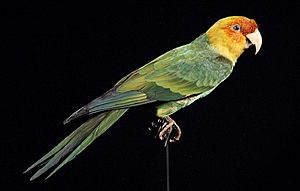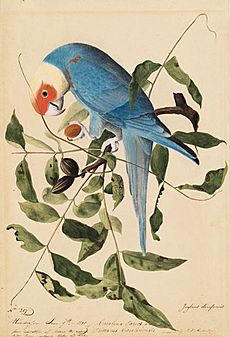Carolina parakeet facts for kids
Quick facts for kids Carolina parakeet |
|
|---|---|
 |
|
| Mounted specimen in the Naturalis Biodiversity Center | |
| Conservation status | |
| Scientific classification | |
| Genus: |
Conuropsis
|
| Species: |
carolinensis
|
| Subspecies | |
|
C. c. carolinensis |
|
| Synonyms | |
|
Psittacus carolinensis Linnaeus, 1758 |
|
The Carolina parakeet (Conuropsis carolinensis) was a small, bright green parrot. It had a yellow head, an orange face, and a pale beak. This bird was once common in the Eastern, Midwest, and Plains states of the United States.
It was the only parrot species naturally found in this area. It was also one of only three parrots native to the U.S. The other two are the thick-billed parrot (now gone from the U.S.) and the green parakeet (still in Texas). Native American tribes had special names for it. The Seminole called it puzzi la née ("head of yellow"). The Chickasaw called it kelinky.
By the mid-1800s, this bird became very rare. The last confirmed sighting in the wild was in 1910. The very last known Carolina parakeet, a male named Incas, died at the Cincinnati Zoo in 1918. The species was officially declared extinct in 1939.
Contents
Discovering the Carolina Parakeet
The first mention of these parrots was in 1583. Sir George Peckham wrote about them in Florida. He noted that explorers found "parrots" in North America.
The first scientific descriptions came from English naturalist Mark Catesby. He wrote about them in his books published in London in the 1730s and 1740s.
American naturalist John J. Audubon observed that cats seemed to die after eating these birds. This was likely because the parakeets ate toxic seeds from plants like cockleburs.

In 1758, Swedish zoologist Carl Linnaeus gave the bird its scientific name, Psittacus carolinensis. The name Conuropsis carolinensis means "a bird like a conure from Carolina."
What Did the Carolina Parakeet Look Like?
The Carolina parakeet was a small green parrot. It was similar in size to today's jenday parakeet and sun conure. Most of its feathers were green, with lighter green on its belly.
It had a bright yellow head and an orange face. This orange color went from its forehead to behind its eyes. Its shoulders were yellow, and the outer edges of its wings were also yellow.
The main wing feathers were mostly green, but the outer ones had yellow edges. Its upper legs were green, turning yellow near its feet. Male and female adults looked the same, but males were a bit bigger.
Their legs and feet were light brown. Like other parrots, they had zygodactyl feet, meaning two toes pointed forward and two pointed backward. The skin around their eyes was white, and their beak was a pale, flesh color. These birds weighed about 3.5 ounces (100 grams). They were about 13 inches (33 cm) long. Their wingspan was about 21 to 23 inches (53-58 cm).
Young Carolina parakeets looked a little different. Their faces and bodies were all green, with lighter green undersides. They did not have the yellow or orange colors on their faces, wings, or thighs. Baby parakeets were covered in gray fuzz. Green wings and tails appeared when they were about 39–40 days old. They got their full adult colors around one year of age.
These birds could live for a long time. A pair at the Cincinnati Zoo lived for over 35 years.
Where Did Carolina Parakeets Live?
The Carolina parakeet lived further north than any other known parrot. Its range stretched from southern New York and Wisconsin down to Kentucky, Tennessee, and the Gulf of Mexico. It lived from the Atlantic seaboard as far west as eastern Colorado.
These parrots lived in old-growth forests along rivers and in swamps. They especially liked the Mississippi-Missouri drainage basin. They used large hollow trees, like cypress and sycamore, for roosting and nesting.
Scientists believe there were once tens of thousands to a few million of these birds. The densest populations were likely in Florida.
Sometimes, a few birds might have flown as far north as southern Ontario in Canada. Some bones found there suggest this. However, it's also possible these birds were brought there for special ceremonies.
What Did Carolina Parakeets Do and Eat?
Carolina parakeets lived in very large, noisy groups. These flocks could have as many as 200–300 birds. They built their nests inside hollow trees. Females would lay two to five round, white eggs. Sometimes, several female parakeets would lay their eggs in the same nest. This is similar to how monk parakeets nest.
They mostly ate seeds from forest trees and shrubs. This included seeds from cypress, hackberry, beech, sycamore, elm, pine, and oak trees. They also ate seeds from plants like thistles.
They enjoyed fruits too, such as apples, grapes, and figs. They would sometimes eat flower buds and even insects. They were especially known for eating cockleburs, which contain a toxic substance. Farmers sometimes saw them as pests because they would eat grain crops.
Why Did the Carolina Parakeet Disappear?
The last Carolina parakeet in captivity, Incas, died at the Cincinnati Zoo on February 21, 1918. He lived in the same cage where Martha, the last passenger pigeon, had died in 1914.
There were no detailed scientific studies of this bird. Most of what we know comes from old stories and museum specimens. So, the exact reasons for their decline are not fully known.
Early explorers often wrote about how common and noisy these colorful parrots were. Parrots were very rare in Europe at that time. By the late 1800s, people noticed the birds were becoming scarce.
Studies of their DNA show that their numbers dropped very quickly. This happened even though their population had been slowly decreasing for a long time.
The birds' range shrank from east to west as people settled and cleared forests. John J. Audubon noted their decline as early as 1832. After 1860, they were rarely seen outside Florida. The last sighting east of the Mississippi River (besides Florida) was in Kentucky in 1878. By the early 1900s, they were only found in the swamps of central Florida.
The last known wild bird was killed in Okeechobee County, Florida, in 1904. The last captive bird, Incas, died in 1918. He died within a year of his mate, Lady Jane. Some people reported seeing the birds in Florida until the late 1920s, but these sightings were not confirmed. In 1939, the American Ornithologists' Union officially declared the Carolina parakeet extinct. The IUCN listed it as extinct in 1920.
In 1937, three parakeets that looked like this species were filmed in the Okefenokee Swamp in Georgia. However, experts decided they were probably wild parrots that had escaped from captivity. A year later, in 1938, a group of experienced bird watchers thought they saw a flock in a swamp in South Carolina. But most other experts doubted this sighting. The birds were never seen again after that. Soon after, part of that area was destroyed for power lines, making it unlikely the species could have survived.
Today, about 720 skins and 16 skeletons of Carolina parakeets are kept in museums worldwide. Scientists have been able to get DNA from these samples.
Why Did Humans Cause Their Extinction?
Humans played a big part in the extinction of the Carolina parakeet.
- Habitat Loss: Clearing forests in the 1700s and 1800s destroyed their homes.
- Hunting: People hunted them for their colorful feathers, which were used to decorate women's hats. They were also hunted to reduce damage to crops. However, some people knew the birds helped by eating harmful cockleburs.
- Pet Trade: Some birds were captured to be sold as pets.
- Competition: The introduction of European honeybees for crop pollination might have competed with the parakeets for nesting spots.
One major problem was their flocking behavior. When some birds were killed, the others would return to the area. This made it easy for hunters to kill many birds at once.
The very rapid disappearance of the species in the early 1900s is still a bit of a mystery. Strong flocks with many young birds were seen as late as 1896. The birds lived long in captivity. But by 1904, they had almost vanished. There were still enough nesting sites, so habitat loss wasn't the final cause.
Some scientists, like Noel F. Snyder, think the birds might have caught a disease from farm birds. However, there is no clear proof of this. Genetic research on samples has not shown any major bird viruses.
Images for kids
See also
 In Spanish: Cotorra de Carolina para niños
In Spanish: Cotorra de Carolina para niños
- Incas (Carolina parakeet), the last Carolina parakeet alive in captivity.
- Thick-billed parrot, one of two living parrots that had a native range in the contiguous United States; now restricted to Mexico
- Green parakeet, the other living U.S. parrot, found in southern Texas
- Monk parakeet, a prevalent feral parrot in the United States, often incorrectly presumed to be native
- Feral parrots, other non-native parrots in the United States






